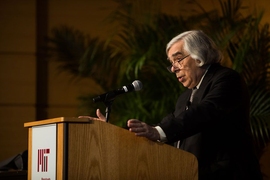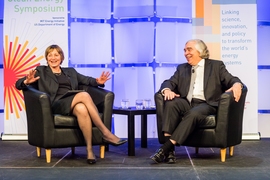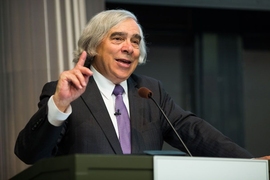Climate and energy are two key areas on the Biden-Harris Administration’s agenda. Here, Robert C. Armstrong, director of the MIT Energy Initiative (MITEI), asks Ernest J. Moniz — professor emeritus post-tenure, MITEI’s founding director, special advisor to MIT President Rafael Reif, and former U.S. Secretary of Energy — about key challenges and targets that the new administration should consider to accelerate significant progress in these areas.
Q: What are your initial thoughts on what the top priority items should be for the Biden-Harris administration?
A: First of all, I think we should start off by saying that it’s pretty clear that the president is going to move out smartly on energy and climate. His appointments speak volumes, starting out with John Kerry in this new international envoy position; with Gina McCarthy; Brian Deese in the White House; Jennifer Granholm as the secretary of energy, who, as the governor of Michigan, did a lot with renewables and transportation; and the choice of Janet Yellen in the treasury with her well-known commitment to carbon emissions pricing.
It’s pretty convincing that the Biden-Harris Administration is in fact going to carry through with their “whole of government” approach to addressing climate. Now, in terms of priorities going forward, I think it’s important to distinguish between the types of actions that he can take. Clearly, there will be a large package of executive actions that can be taken without Congress.
Frankly, some of those will be reversing what Trump rolled back. Some examples of rollback to Obama-Biden rules, possibly further strengthened under Biden-Harris, could include Corporate Average Fuel Economy (CAFE) standards for auto efficiency and methane emissions rules.
There will also be a restart of some major Obama-Biden activities. One that I was very close to while energy secretary was energy efficiency standards. During the Obama period, the Department of Energy issued more than 50 energy-efficiency standards. We’re talking more than half a trillion dollars of consumer savings and about two to three gigatons of CO2 avoided cumulatively to 2030. You’re going to see that come out like gangbusters, maybe even more aggressive than when we were in the Obama administration.
Rejoining the Paris Agreement is a no-brainer. Getting in as a notification on Day One, and then 30 days later we’re in. Now, what do you do with it? The very early announcement of John Kerry’s position as international climate envoy was a clear statement that we don’t want to just rejoin Paris, we want to re-establish a leadership position. Other countries haven’t taken a four-year vacation on this. They’ve been working hard at it. We have to earn our place back at the table. A major test in the next few months will be formulation of a much more aggressive nationally determined contribution for 2030 than that adopted for 2025 at the Paris climate meeting just over five years ago, while also describing a domestic program that can credibly reach the goal. It will be tough to thread this needle.
These are only a few highlights of things that will be reestablished, but there will also be some new elements as well. For example, I believe that he will order all the financial regulatory agencies to put corporate climate risk disclosures very high on the agenda, reinforcing what the private banks and investors do in terms of the environmental, social, and corporate governance movement. It’s going to be a major executive package that the administration can put in place.
Q: There have been a lot of interesting climate and energy experiments and aggressive programs at the state and regional levels around the country. What lessons can be learned from these examples and how can we take national legislative action that leverages what we have already learned?
A: Despite the newfound Democratic majority in the Senate, I don’t think we should be fooled into thinking that it’s going to be easy to get comprehensive legislation immediately. Frankly, there’s a lot of work to do in bringing the Democrats together in terms of what kinds of programs are actually needed. If we assume, and I do assume, that once again we will not have comprehensive legislation on matters such as significant carbon emissions pricing anytime soon, state and city leadership will continue to be very important because in these past few years, clearly states and cities have been the ones leading the charge, often with opposition of the federal government.
Moving forward, there will be synergy between what the states and cities and the administration want to do. One should not underestimate how that will free up a lot of state and city initiatives on the path to the UN Climate Conference in Glasgow in late 2021, reinforcing a magic year of repositioning America on climate and clean energy. For example, I’m expecting that the considerable number of net-zero declarations by cities and states (and companies too) will only be strengthened. Clearly, national comprehensive legislation is desired and will eventually be very important, but we’ve always emphasized that, even with national legislation, we should never lose sight of the fact that low-carbon solutions are fundamentally regional in nature. This is a key direction that the Biden-Harris administration can go in even without comprehensive legislation. Facilitating and encouraging these kinds of regionally focused solutions is the only way we’re going to reach the net-zero objective.
Going back to Congress, there are two areas that I feel are ripe for congressional bipartisan action: innovation and infrastructure. Innovation is where the Congress in the last four years has shown promising bipartisan support. This is the decade where we need supercharged innovation because if we don’t get that addressed in this decade, we’re not going to have the scale potential in the 2030s and ’40s that we’re going to need for the mid-century net-zero goal.
Congress knows that they cannot kick the can down the road any further on infrastructure. The money has to be found and that will include as an important subset, energy infrastructure. That will obviously include the electricity system, for example, but it will also include things such as the infrastructure that is needed for large-scale carbon management and the infrastructure for large-scale, multi-sectoral hydrogen development. With innovation and infrastructure, I do believe that we’ll be able to garner strong bipartisan support. Clearly once we get into more difficult areas, that may take more time.
Q: Many argue that clean power generation alone will not be enough to address the climate and energy crisis alone and that carbon removal technologies will prove to be essential get us there. This begs the question about what the Biden-Harris administration might do to address these areas. How could they incentivize carbon capture, utilization, and sequestration (CCUS) technology or carbon dioxide removal (CDR) to help make it more affordable and appealing for large scale implementation?
A: Some people argue against admitting that CDR should be part of the solution because it is interpreted as giving more life to fossil fuels. I think that’s completely the wrong way to look at it. The right way to look at it is to recognize net-zero economy-wide emissions as just one milestone on the way to net-negative emissions, and it’s a tautology that you can’t do net-negative if you don’t have negative carbon technologies. The more that one can develop, demonstrate and deploy these technologies now, the more we’re getting a leg up to the place where we really want to go in the future, and of course at the same time, it’s going to help us with the mitigation challenge along the path to net-zero.
We’ve been advancing quite strenuously this carbon dioxide removal agenda, and it’s getting a lot of traction. The energy bill that was attached to the Omnibus Appropriations Bill and signed by the former president on Dec. 21, 2020 provided a lot of support for these technologies. This includes the support of a broad research portfolio on the topic and also requires a cross-administration CDR committee. The energy bill also authorized six big CCUS demonstration projects. Moving those forward will be very important, but where I think the government has to come in in a new way is to also be looking at the simultaneous build-up of the infrastructure to service these areas.
In this decade, we could start with a set of discrete hubs to advance the infrastructure of CCUS, CDR, and hydrogen, and the federal government can play a huge role in getting that to happen in collaboration with cities, states, and regions nationwide.











